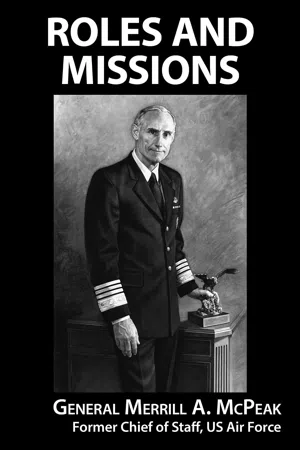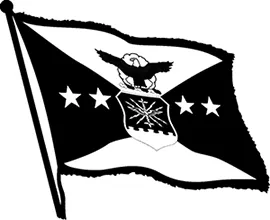![]()
Chapter 1
Desert Storm
Never send a man where you can send a bullet first.
—Samuel Colt
Washington can be a miserable place in the best of times, but being trapped in the Pentagon during a shooting war is surely one of the city’s more exquisite agonies. That I’d taken up duties as the Air Force’s chief of staff following Mike Dugan’s dismissal did nothing to lighten the load. Dugan’s predictions about the war were in line with the views of most airmen, mine included. He’d committed the capital city’s gravest sin: being right too soon. So here I was, with nothing much in the way of fresh ideas to offer, manifestly a second-stringer, the substitute whose unanticipated insertion into the game can only disappoint the crowd.
Secretary Dick Cheney and Pentagon General Council Terry O’Donnell swear me in as the Air Force’s 14th chief of staff.
More to the point, the Gulf War was coming on fast. One could argue it made little sense to switch service chiefs in the midst of a buildup for war. Frankly, it didn’t matter much, the chiefs having been marginalized in an era of “jointness.” But if I had any illusions about my importance in upcoming events, they quickly dissolved. In Washington, uniformed leadership was firmly in the hands of General Colin Powell, who dominated military discussions and decision making and who embodied the sole connection to higher civil authority. Powell was smart and gutsy, so worse things can happen to the country.
Powell had played a role in bringing me to Washington. He wanted a quick replacement in view of the situation in the Gulf, and I was an obvious choice, having come second to Dugan only a few months earlier. Powell had met me in Honolulu during one of his visits to outposts. He checked with Vice Chairman David Jeremiah, who said we’d worked well together as component commanders in the Pacific. Jeremiah described me as a “team player”—unlike Dugan, evidently.
By way of professional background, Powell was an infantryman and Jeremiah a surface sailor. As for the other service chiefs, Carl Vuono was an artilleryman, Al Gray a Marine infantryman, and Frank Kelso a submariner. None of these gentlemen had a reputation for passionate airpower advocacy. I’d be the outlier, convinced airpower would prove decisive in the coming combat. (Of course, Dugan had already been removed for saying this, though maybe not in just the right way.) In JCS deliberations, I’d also be the new guy, someone who should perhaps observe a period of respectful freshman silence. As a consequence, I worried a little about the lack of an authoritative Washington voice able to address the problems and prospects of the impending air campaign.
The Joint Chiefs meet with the president in the Oval Office.
Happily, the situation was different where it mattered most, in the theater of operations. There, for the first time, an officer who had never worn an Army uniform, who had spent his entire career practicing and preparing for aerial warfare, would lead the air campaign.
Chuck Horner
According to the way the Pentagon subdivided the world for military operations, the Middle East was part of Central Command, which had its peacetime headquarters at MacDill AFB, in Tampa, Florida. Army General Norman Schwarzkopf was in charge there. Lt. Gen. Chuck Horner, commander of Tactical Air Command’s Ninth Air Force, located at Shaw AFB, South Carolina, headed up Central Command’s Air Force component, known as Central Command Air Forces (CENTAF). At the start of Desert Shield, Horner had been running Ninth Air Force and CENTAF for more than three years. Having visited the Gulf many times, he knew and worked well with local political and military figures. In command at Riyadh for phase one of Desert Shield, Horner did an impressive job coordinating initial defense preparations and the early stages of reinforcement by all the services.
I’d known Chuck Horner for a long time. An F-100 pilot at Lakenheath, he had later transitioned to the F-105 and flown a noteworthy combat tour in Southeast Asia as a “Wild Weasel,” stimulating, then attacking surface-to-air missile defenses—fun work but not calculated to enhance longevity. As a three-star, he stayed current in the F-16, earning the respect of aircrews and keeping him trained, practiced in modern air combat. A cutup as a youngster, he’d matured a bit but was still cheeky, something of a jester with friends. Scruffy, a little disheveled, having lost the battle of the waistline, he might not be what one thought of as the picture-perfect military officer, but he was comfortable inside his skin and sneaky smart. When it came to the mission and the people entrusted to him for its accomplishment, he was engaged, deeply serious, the opposite of frivolous.
Planning the Air Campaign
By the time I arrived in Washington, Horner had already put together an overall concept for air operations and was assembling a team to draw up tasking orders for its first few days. To help with detailed planning, Horner tapped Brig. Gen. Buster Glosson, who had arrived to be deputy commander of the Joint Task Force Middle East just as Iraq invaded Kuwait. In Riyadh, Glosson ran a compartmented planning cell eventually nicknamed the “Black Hole”—information went in, nothing came out—that did much of the work. Its members got help from the Air Staff’s “Checkmate” office, a group of savvy young officers headed by Col. John Warden. Early in the buildup phase, Checkmate drafted the outline of an air campaign notable for its rejection of the gradualism that had hobbled our effort in Vietnam. Warden briefed this plan, called Instant Thunder, to Schwarzkopf, at CENTCOM’s Tampa headquarters. Schwarzkopf liked it. Warden took it to the Gulf, accompanied by Lt. Col. Dave Deptula, a very bright officer assigned to Secretary of the Air Force Donald Rice’s personal staff. Warden returned to the Pentagon, but Deptula stayed in-country, taking on a continuing planning role.
As originally structured, the air campaign would unfold in four phases. To open phase one, “D-day” featured an overwhelming night attack on Iraqi air defenses, command and control facilities, and high-priority sites known to support Scud short-range ballistic missiles and Iraq’s nuclear, biological, and chemical weapons programs. Follow-up attack on phase-one targets would continue as necessary throughout the campaign, but we thought we could inflict adequate levels of damage in about seven days.
Phase two called for attacking the logistics infrastructure—roads, bridges, the rail network, en route supplies—supporting Iraq’s army deployed in and near Kuwait. We aimed to isolate that army and run it out of food, ammunition, and POL.
Phase three would be the direct aerial attack on the deployed Iraqi Army—a “softening up” phase, during which we hoped to destroy or immobilize something like 50 percent of their heavy equipment, especially tanks, artillery, and armored personnel carriers. Together, phases two and three should require another three weeks, but we saw them as open ended in the sense that our own ground attack, called G-day, would start only when Schwarzkopf judged we had inflicted appropriate damage levels.
Phase four was the post-G-day direct air support of our ground attack.
An Embarrassment of Air
Horner had overwhelming force available for the air campaign. Already by 1 November 1990 the US Air Force alone had brought in 700 aircraft, more than half of them combat types or “shooters,” and more than 31,000 people. At this point, CENTAF by itself easily outclassed the entire Iraqi Air Force. But on 8 November, the day after I swore in as chief, President Bush announced we would enter a second phase of Desert Shield. Thereafter, US forces in the Gulf nearly doubled in size. By D-day, 17 January 1991, CENTAF alone possessed more than 1,100 aircraft of all types and 47,000 people. We continued to augment during the active combat phase so that by 1 February the US Air Force had 693 combat and 487 support aircraft, and more than 55,000 people in-theater.
But CENTAF constituted only a little more than half the total friendly air order of battle. To complete the picture, on 1 February the US Navy had 318 combat and 117 support aircraft, and the Marine Corps 182 combat and 293 support aircraft in-theater. All of these figures included helicopters. The Army also brought in a very large number of helicopters—more than 1,500—and a few support aircraft. Coalition partners added even more airpower. Saudi Arabia, the United Kingdom, France, Canada, and Italy all made sizable contributions. Bahrain, Kuwait (the Free Kuwait Air Force in exile), Qatar, and the United Arab Emirates (UAE) were important participants. Symbolic but much appreciated assistance came from the air forces of Australia, New Zealand, South Korea, and Argentina.
There was simply no way the Iraqis could expect to make a fight of it. Iraq’s air force had about 550 fighter, bomber, attack, and reconnaissance aircraft in frontline service. These numbers made it the world’s sixth-largest air force, about three-quarters the size of Britain’s Royal Air Force. But many Iraqi aircraft were of marginal quality, training levels were suspect, and they were badly organized.
Iraq’s air combat force was split between two organizations: Air Defense Command and Air Support Command. Defense Command was responsible for protecting strategic targets and airfields. It controlled all fighter-interceptor units, air-surveillance radars, the control and reporting system, and those army units equipped with SAMs and antiaircraft artillery assigned to defend strategic targets. Support Command was responsible for reinforcing the operations of the Iraqi Army and Navy. Into this command went all fighter-bomber, bomber, and reconnaissance units. The Scud missiles belonged to the Iraqi Army, as did mobile AAA, SAMs, and all battlefield helicopters. Thus, command of Iraqi air was disjointed, some units controlled by the air force but structurally compartmented, and some belonging to the army.
As a consequence—and in common with the armed forces of many countries—Iraq had given little thought to the difficult problem of conducting integrated air operations, including how to sort friendly from hostile aircraft in a confused tactical situation. During the Iraq-Iran War of the 1980s, the Iraqi Army put a SAM and AAA umbrella over its ground forces; gunners and missile crews considered all approaching aircraft hostile. Reportedly, more than three-quarters of Iraqi aircraft lost during that war were downed by “friendly” fire. In the Desert Storm engagements about to occur, Iraqi pilots had every reason to believe both sides would harass them continuously until they got back on the ground.
Considering the weakness of the threat, coalition air forces enjoyed an embarrassment of riche...



